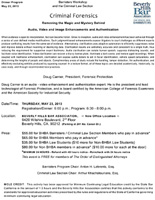
|
|||||||
|
|||||||
When evidence is open to interpretation, fact can become fiction. Since its inception, audio and video enhancement has been achieved through a series of user defined media modifications. Such judgment-based enhancements expose litigators to court challenges as different experts produce conflicting results from the same set of evidence. Alternatively, clarification uses adaptive automation to efficiently suppresses noise and improve details without inventing or destroying data. Clarification results are extremely accurate and consistent to a single truth, thus reducing the requirement for supportive expert testimony. Audio clarification can isolate human speech, suppress distracting sounds, and facilitate voice identification. Video clarification can recover a blurry license plate, illuminate a dark scene, and restore aged recordings. When coupled with traditional enhancement, clarification can expose subtle details to aid in facial identification, vehicle speed calculations, and determining the heights of people and objects. Complimentary areas of study include file handling, tamper detection, file authentication, and effectively excluding exhibits produced by opposing counsel. In a lecture format, all of these topics are detailed academically, historically, by case study, and through recommended best practices. Doug Carner, President, Forensic Protection Doug Carner is an audio - video enhancement and authentication expert. He is the president and lead technologist of Forensic Protection, and is board certified by the American College of Forensic Examiners and the American Society for Industrial Security. BarristersProgram Chair: Anton H. Labrentz, Esq. Criminal Law Section Chair: Arthur Khachatourians, Esq. MCLE CREDIT: This activity has been approved for Minimum Continuing Legal Educations credit by the State Bar California in the amount of 1.5 hours and the Beverly Hills Bar Association certifies that this activity conforms to the standards for approved education activities
prescribed by the rules and regulations of the State of California governing minimum continuing legal education. |
|||||||
|
